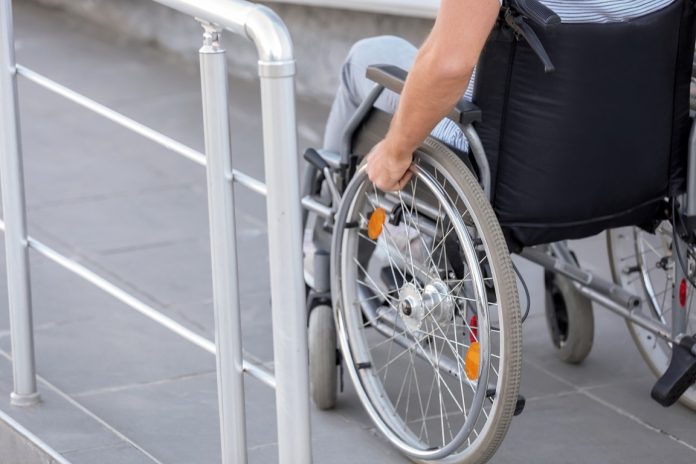Ian Streets, managing director of About Access, calls for compromise to help make the built environment accessible to all
Consultation is key when it comes to planning a new development, a major refurbishment of an existing property or even just a review of accessibility, possibly as the first step towards a programme of improvements.
But as important as including disabled people in that conversation is the need for all concerned to take a pan-disability approach. Failing to do that means you can only address some of the potential problems.
When we audit a property, we don’t just look for opportunities to install ramps as an alternative to steps. We examine how a project can meet the needs of a wide range of people who have different impairments and we identify those needs by carrying out detailed and varied consultations, and by building a bank of knowledge, experience and contacts.
Inevitably, that involves consulting with disabled people. It’s not essential for an accessibility professional to have an impairment but it is vital for them to have an expert understanding of obstacles to access, of the impact a project may have on people with different impairments and of how any issues can be prevented, overcome or mitigated.
Consulting disabled people
The National Register of Access Consultants (NRAC) is the only accredited body for access consultants in the UK and includes a number of disabled people within its membership. I’m not disabled but I’ve worked successfully as an access consultant for many years because I’ve endeavoured to identify the features which make the built environment disabling. I also recognise that a disabled person will have a much better idea than me of what it’s like to encounter discrimination.
There are many examples where designers, developers or organisations have consulted disabled people as part of their work on a construction or refurbishment project.
We became aware of one example where the consultation led to the provision of a Changing Places facility for use by visitors to a nice countryside walking area. But what the consultation didn’t reveal was the need for a corner accessible WC. It’s important to understand that a Changing Places isn’t suitable for independent use – it can only be used by people who have assistance and it is therefore inaccessible to a lot of disabled people.
The example indicates that the feedback was incomplete and that the people who provided it considered their own needs and their own situation, but they didn’t take a pan-disability view.
Where we have organised our own consultations, we have ensured that we take a pan-disability approach. A session that brought together people to consider options for improving accessibility in and around a collection of museums and galleries benefitted from the input of wheelchair users, blind and visually impaired people, some with hearing impairments and others with cognitive impairments and other hidden disabilities.
A visually impaired delegate made some particularly important contributions and in doing so, reinforced the need to take a pan-disability approach. They completely accepted that some of the adjustments required to make exhibits and displays accessible to a visually impaired person could actually create additional difficulties for someone who has a hearing impairment. They also noted that although ramps are essential for wheelchair users, using them can become an ordeal for someone who has vertigo.
We have been monitoring the situation at a city centre transport hub where, as part of a major redevelopment, it was proposed to relocate a taxi rank further away from the main entrance. The reasons are to improve security and to plan for the future by enabling better management of increasing footfall and traffic congestion.
There has been opposition from some disabled people but there is plenty of evidence that the designers have taken a reasonable approach that is intended to meet the needs of a wide range of users. The taxi rank is only being moved a short distance, extra seating will be provided and there will be assistance to help people get from the taxis into the transport centre.
Such hubs are used by different types of transport – taxis, buses, trains and pedestrians – and they need to be accessible to non-disabled people, wheelchair users and people with other mobility issues, visual impairments, hearing impairments, cognitive impairments.
For example, blister paving at drop kerbs helps blind and partially sighted people identify where they are leaving the safe area of a pedestrian route and entering a traffic area – but it can also creates problems for wheelchair users and people who have arthritis in their feet or hips, also people who have to wear thin-soled shoes.
There’s no “one-size fits all” and if you want to make the built environment as accessible as you possibly can then reasonable compromises have to be made.
Ian Streets
Managing director
About Access
Tel: +44 (0)1482 651101
Please note: this is a commercial profile.













![[VIDEO] Making DorTrak reports easy to read with Fireco Inspecting fire doors at Fireco, firedoor technology, 2023](https://www.pbctoday.co.uk/news/wp-content/uploads/2024/04/JPZ_2364-web-218x150.jpg)
![[VIDEO] Re-flow Field Management review by Traffic Management Installations When TMI began subcontracting for councils and government bodies, they wanted to present their site reporting in a more professional manner](https://www.pbctoday.co.uk/news/wp-content/uploads/2025/03/TMI-Media-1-218x150.png)